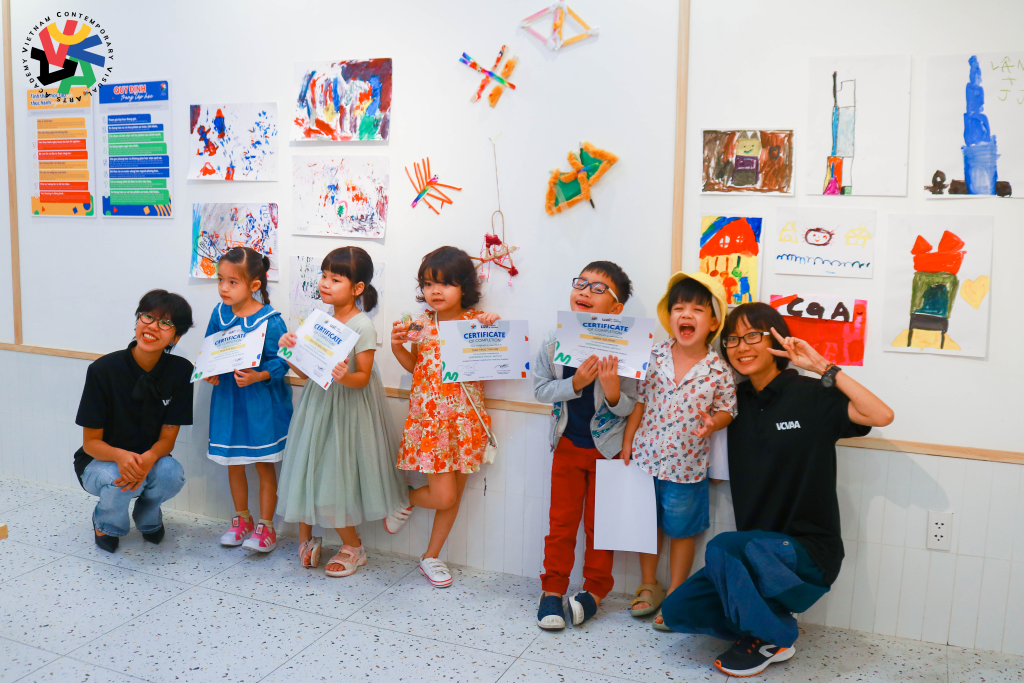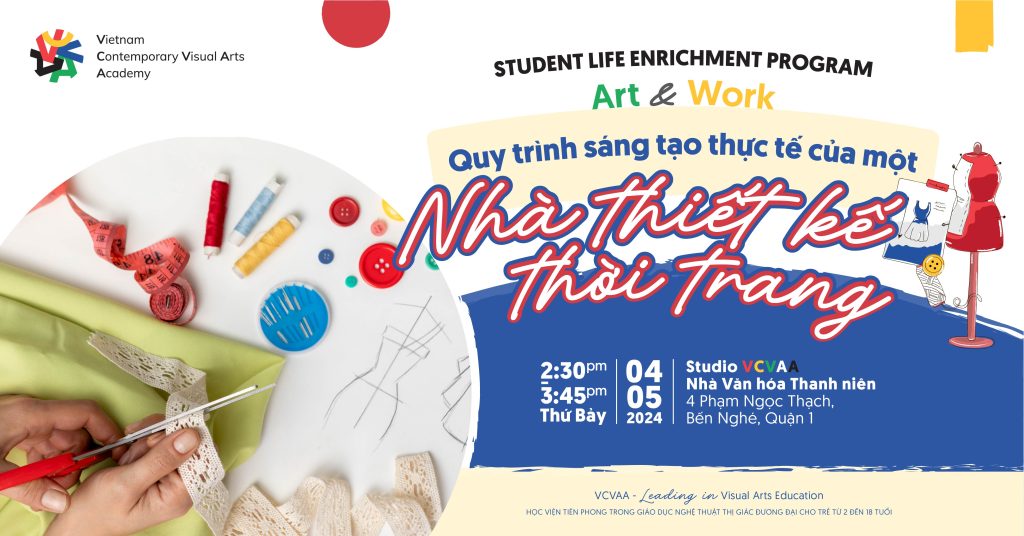Main content:
• The significance of art exhibition tours for a child’s development
• Guidelines and tips for a complete tour
• Ways to observe and discuss artworks with your child
• Creative activities to engage with art exhibition spaces
• Introduction to art exhibition spaces in Ho Chi Minh City
THE SIGNIFICANCE OF ART EXHIBITION TOURS IN A CHILD’S DEVELOPMENT
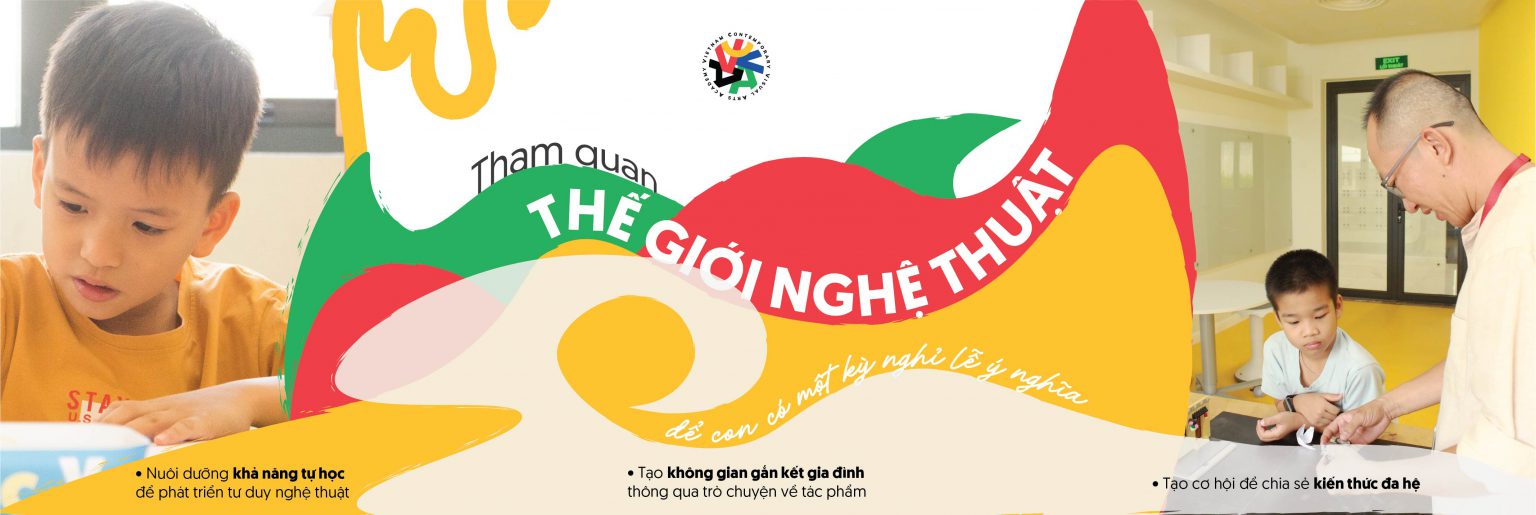
- Nurturing self-learning ability. Children always have thousands of questions about the world around them. Asking a lot of questions helps stimulate their curiosity and exploration. Open spaces, including museums, exhibitions, or art exhibition spaces, serve as sources of inspiration for questions within children.
- Developing artistic practical thinking. A research project on art education by Harvard University has identified 8 habits of practical thinking in nurturing and developing creativity, including Understanding the art world. Practicing outside the classroom encourages children to expand their knowledge of art. Let’s reverse the course of history through visits to museums or enjoy the daily changes in art within our own community.
- Creating space to bond as a family through discussions about artworks. Whether it’s many or few, artworks in exhibition spaces always evoke thoughts, feelings, and emotions in each individual. When these shares are genuinely acknowledged to create meaningful conversations, fascinating and unexpected moments of discovery will bring joy and deepen the understanding and love for loved ones each day.
- Providing opportunities for intergenerational knowledge sharing. Have you ever felt that the way stories from the past were told by our grandparents made us feel like we were living in that era, even though we never lived at that time? When family members’ knowledge or opinions are accumulated and formed through life experiences, children will be able to see life from different perspectives, enriching their experiential bank. Note that sharing from parents should be in the form of storytelling and encourage exchanges with children.
IMPORTANT TIPS FOR A COMPLETE TOUR
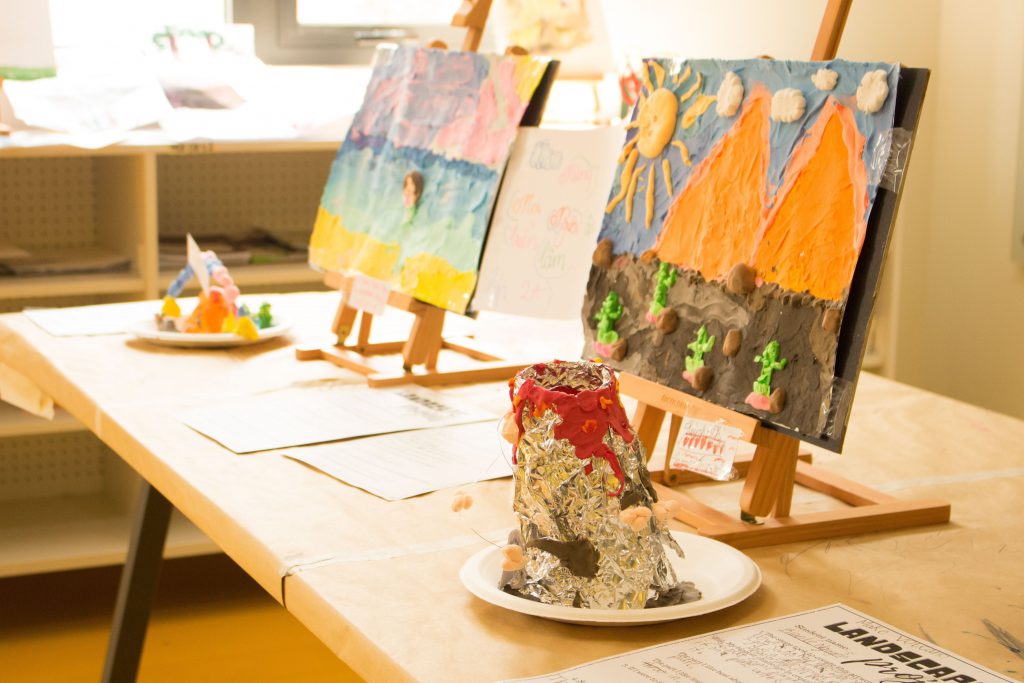
Artworks exhibited at the flagship class of the Vietnam Contemporary Visual Arts Academy (VCVAA)
• Being present together and complete. When visiting an art exhibition space, the beauty lies not only in the artworks but also in the process of parents and children looking and discussing the artworks and the creative process of the artists.
• Take slow steps to not miss the wonders. Families don’t need to see every single painting present. Choose one or two areas and spend quality time there – looking and discussing the amazing things happening.
• Protect the artworks. You and your children can stand close to observe, but be careful not to touch to preserve the integrity of the artworks.
• Maintain order. We can ask questions, have conversations, and exchange thoughts to establish our own connection with the artworks, but let’s be gentle and respect the shared space with others.
• Listen to the guide, if available. Museums or art exhibition spaces often have docents to introduce the stories of the artists and the artworks present. Let’s pay attention and focus on them to learn more about the stories behind the exhibition.
Before visiting an art exhibition space, parents should share and ensure that children understand and are aware of these guidelines. This helps prepare the family with a ready mindset and ensures the full presence of everyone to enjoy the art exhibition space.
HOW TO OBSERVE AND DISCUSS ARTWORKS WITH YOUR CHILD
When standing in front of an artwork, besides observing and appreciating it, VCVAA encourages parents to actively ask open-ended questions to initiate discussions about the artwork. It’s important to note that a conversation about art doesn’t have definitive right or wrong answers for the questions and responses. Openness and sincerity are the keys to making art discussions meaningful.
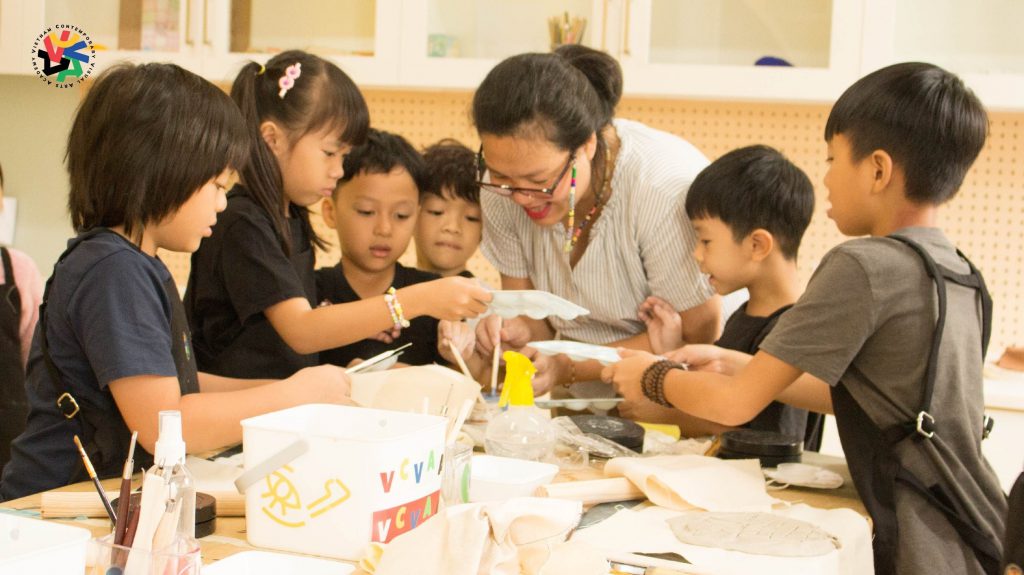
Teachers and young students in the pottery class
Meaningful conversations about art will help:
- Create opportunities for students to reflect. For example, when they see a painting about trees, they can recall the trees or landscapes they have visited that have many trees.
- Reinforce confidence and comfort in expressing thoughts, emotions, and personal perceptions towards their own artwork.
- Develop and enhance language skills, particularly in applying vocabulary related to art.
Here are four steps for parents and students to enjoy the process of observing and discussing artworks:
- Describe: Observe and explore what appears in the artwork, including subjects and artistic elements.
Some open-ended questions may include:
- What do you see in the artwork: colors, lines, shapes, people, objects?
- How would you describe this artwork to someone who hasn’t seen it before?
- If you could be in the painting, where would you place yourself?
- Analyze: Think together about how the artist arranges the elements (e.g., lines, colors, shapes, volume, negative space, surface texture) in their own pottery or the techniques used by the artist in the artwork (e.g., tools, materials).
Some open-ended questions may include:
- When glancing over the artwork, what first catches your eye?
- Why did the artist choose to depict that object in the center?
- Why did the author combine these colors together?
- What do you think the artist used to create this pottery or what materials did they use?
- Interpret: The title or introduction of the artwork will provide hints for us to understand more about the immediate artwork, such as its historical background or the artist’s inspiration.
Some open-ended questions may include:
- What do you think the artwork wants to say or what story does it tell?
- Where and when do you think the painting was created?
- Where do you think the artist got the idea for this artwork?
- Evaluate: Think about the message that the artist wants to convey through the artwork.
Some open-ended questions may include:
- What thoughts or feelings do you have about the artwork?
- Why do you like or dislike this artwork?
- What do you like or dislike about the artist’s style?
- If you could change one thing about this artwork, what would you change?
Additionally, parents can have conversations with their children using the following questions:
- If you could interview the artist, what questions would you ask?
- (For museums or exhibitions featuring art forms beyond painting and drawing) Is it necessary to be a good drawer to become a skilled artist?
- Are artworks from ancient times still worth viewing today?
- What would you do with this artwork if you owned it?
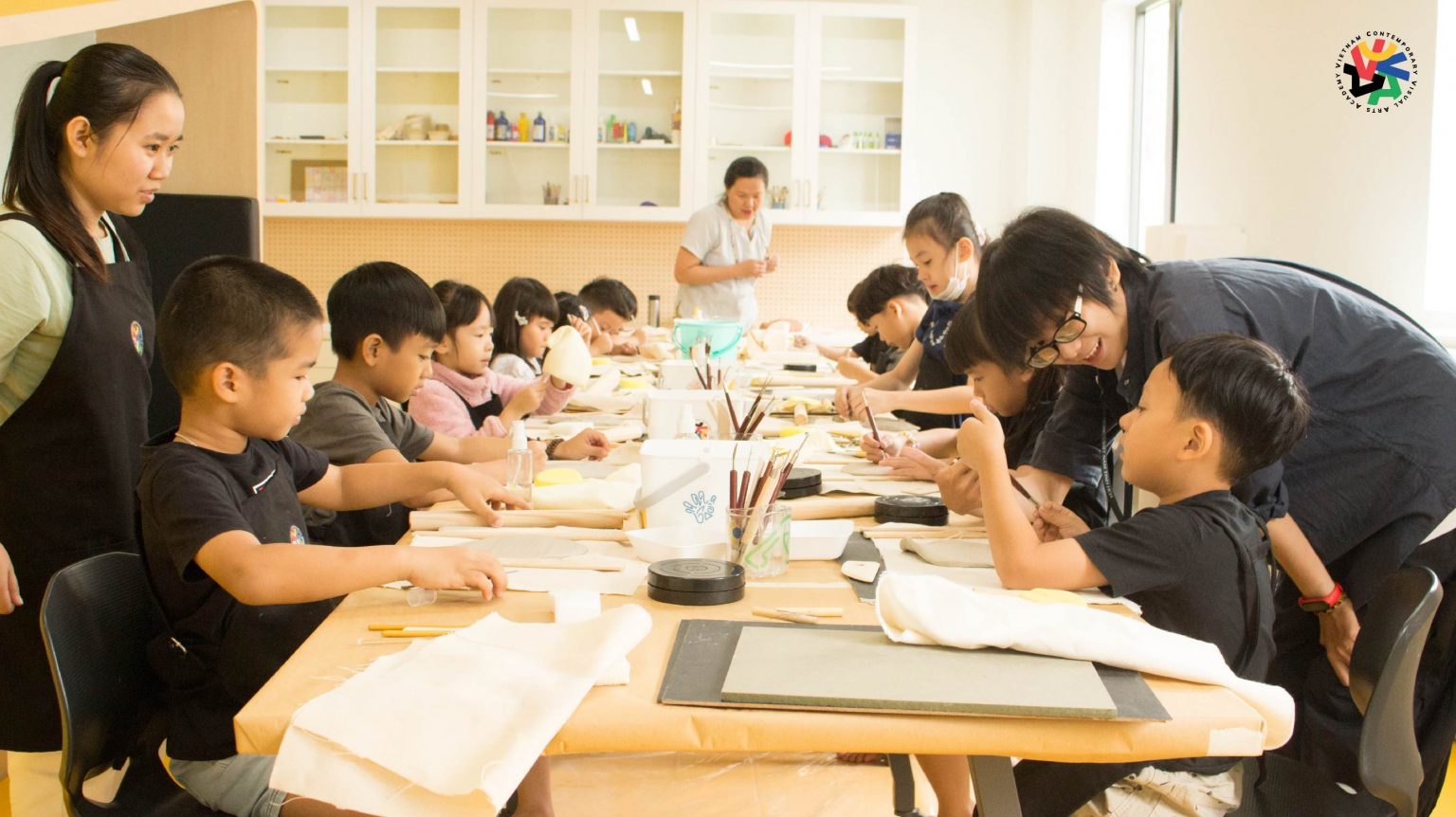
Caring teachers support young students in the pottery class
CREATIVE ACTIVITY SUGGESTIONS TO ENGAGE WITH ART EXHIBITION SPACE
When visiting museums, in addition to observing and discussing artworks, parents can organize interactive activities with their children to stimulate imagination and connect their own life experiences with the museum visit. Here are some suggestions from VCVAA to bring excitement to the journey of exploring the art world with your child:
- Treasure Hunt: Search for paintings with similar themes, such as those featuring people or animals.
- Creative Drawing: Create an inspired artwork influenced by the pieces or artists that impress your child the most.
- Body-Based Art Experience: Remember and reenact a painting your child has seen, focusing on posture, facial expressions, lines, or shapes.
- Imaginary Storytelling: Imagine the scenario before or after the depicted scene in a painting and create a story around it.
- Multisensory Connections: Parents can ask open-ended questions like:
- If you were inside the artwork, what would you see/hear/taste/smell/feel?
- If the artwork produced sound, what kind of sound do you think it would make?
These are initial suggestions for parents to bring joy to their visits to art exhibition spaces with their children. Parents and young students can come up with even more creative ideas for their journey together!
INTRODUCTION TO ART EXHIBITION SPACES IN HO CHI MINH CITY
In the city, families can find a variety of art exhibition spaces to visit, such as museums, galleries, or art rooms showcasing permanent collections or regularly organized art exhibitions. Here are some places that parents and children can explore to discover the art community in Ho Chi Minh City!
Note:
- The listed places are just initial suggestions for parents and children. VCVAA encourages parents and children to actively search for and explore other art exhibition spaces to broaden their understanding of the art community.
- Exhibitions in art exhibition spaces are organized based on themes. Therefore, before visiting, parents can consider the suitability of the theme for their child’s age through the introductory information provided by the venues.
- Ho Chi Minh City Fine Arts Museum
- Address: 97A Pho Duc Chinh Street, Nguyen Thai Binh Ward, District 1, Ho Chi Minh City
- Opening hours: 9:00 am – 8:00 pm, from Tuesday to Sunday
- Fanpage: https://www.facebook.com/mfahcmc
Additionally, to encourage interdisciplinary thinking, parents should create opportunities for children to visit museums with diverse themes such as history, nature, etc.
- REI Artspace
- Address: 371/4 Hai Ba Trung Street, Ward 8, District 3, Ho Chi Minh City
- Opening hours: 9:00 am – 8:00 pm, from Monday to Sunday
- Fanpage: https://www.facebook.com/REI.Artspace/
- Currently ongoing: 08/04 – 07/05 | Solo exhibition “Come Here and Sit Down” by artist Trieu Phuong
- Galerie Quynh
- Address: 118 Nguyen Van Thu Street, Da Kao Ward, District 1, Ho Chi Minh City
- Opening hours: 10:00 am – 7:00 pm, from Tuesday to Saturday
- Fanpage: https://www.facebook.com/galeriequynh
- Currently ongoing: 15/04 – 03/06 | Exhibition “Songs of Singularity” by artist Trong Gia Nguyen
- Ho Chi Minh City Fine Arts Association
- Address: 218A Pasteur Street, Ward 6, District 3, Ho Chi Minh City
- Opening hours: 8:00 am – 9:00 pm, from Monday to Sunday
- Fanpage: https://www.facebook.com/hoimythuattphcm.vn
- The Factory Contemporary Arts Centre
- Address: 15 Nguyen U Di Street, Thao Dien Ward, Thu Duc City
- Opening hours: 10:00 am – 7:00 pm, from Wednesday to Saturday
- Fanpage: https://www.facebook.com/thefactorycontemporaryartscentre
- Lotus Gallery
- Address: 12-13 N1 Street, Tan Thuan Ward, District 7, Ho Chi Minh City
- Opening hours: 9:00 am – 6:00 pm, from Monday to Sunday
- Fanpage: facebook.com/lotusgalleryhcm
NGUỒN THAM KHẢO CHO BÀI VIẾT:
- Andre, L., Durksen, T. & Volman M. L. (2017). Museums as avenues of learning for children: a decade of research. Learning Environments Research, 20, 47-76. Link: https://link.springer.com/article/10.1007/s10984-016-9222-9
- National Endowment for the Arts (2014). The importance of taking children to museums. Link: https://www.arts.gov/stories/blog/2014/importance-taking-children-museums
- Artsy (2018). How to Talk to Kids about Arts. Link: https://www.artsy.net/article/artsy-editorial-talk-kids-art
- Harcourt School Publishers. Visiting a museum trong Arts Everywhere.
- The Metropolitan Museum of Art (2021). Family Guide Family fun at the MET. Link: https://www.metmuseum.org/-/media/files/learn/family-map-and-guides
- Kids in Museums (2020). 10 museum activities to keep children entertained. Link: 10 museum activities to keep children entertained – Kids in Museums

